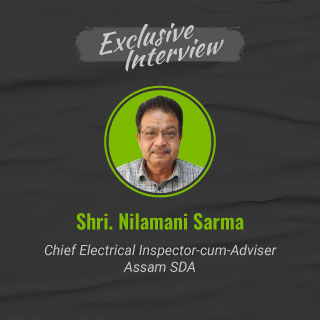
Assam State Designated Agency (SDA) is paving the way for an energy efficient future and leading by example as it makes concerted efforts towards an energy transition in the state. In recognition of these efforts, Assam was conferred with the first prize in the “State Designated Agency (Group-III)” category at the Ministry of Power’s National Energy Conservation Awards held in December 2022.
In an exclusive interview with AEEE, Shri Nilamani Sarma, Chief Electrical Inspector-cum-Adviser, Assam SDA highlighted the need for a cross-cutting approach to energy efficiency adoption that leverages collaborations to create innovative solutions and implement them. He, further, discussed the existing barriers to the adoption of energy efficiency at the state level and how Assam is overcoming these and working across sectors to achieve energy efficiency targets.
Q1. The process of forming a state-level steering committee for energy transition is in process in all the states. What is your perspective on the role of energy efficiency in energy transition at the state level?
Energy efficiency is a crucial factor in energy transition, particularly at the state level. It has huge potential to reduce the overall energy consumption of a state, thereby reducing the need for large-scale energy production. By improving the efficiency of existing energy sources through installation of more efficient technologies, a state can reduce its reliance on traditional fossil fuels and transition towards more sustainable sources of energy. Additionally, energy efficiency initiatives can help reduce costs associated with energy production, allowing states to reinvest those savings in other important areas such as education and healthcare. Ultimately, increased energy efficiency can help states achieve their energy transition goals in a rapid and cost-effective manner.
Q2. What are the three most impactful programs in place in your state in the energy efficiency domain across different sectors?
- State Partnership for Energy Efficiency Demonstration Project: Under this program, the Assam SDA is undertaking energy efficiency projects in 100 government schools to showcase the energy savings potential in the institutional building sector through retrofitting of energy-efficient appliances. The annual energy savings from lighting systems and fans are estimated to be 250.06 MWh and 447.64 MWh respectively.
- Energy Conservation Building Code: Energy Conservation Building Code Rules for commercial buildings have been notified in the state and as per the notified Assam ECBC rules 2020, any upcoming commercial building in the state having a connected load ≥ 100 kW or contract demand ≥ 120 kVA will fall under the scope of ECBC compliance. Implementation and enforcement of ECBC in building bye-laws of Guwahati and other ULBs is in progress. Further, the draft Assam Eco Niwas Samhita (ENS) codes for residential buildings has been prepared and all upcoming residential single unit or mixed buildings of plot area 500 m2 or above will come under the scope of ENS compliance. Various workshops on ECBC and ENS have also been conducted as a part of awareness/capacity building activity.
- PAT Scheme: : The assessment of 17 Designated Consumers of Assam on energy compliance targets under PAT cycle has been successfully completed. Monitoring and verification (M&V) audits of the DCs under PAT cycle IV and analysis of the corresponding reports are in process.
Q3. Please share your state’s strategy to enhance energy efficiency adoption in the priority sectors in the near and medium term.
Assam SDA is working continuously to achieve energy efficiency in the state as per the set targets. There are multiple sectors across which we have initiated energy efficiency programs such as agriculture, municipal, building, transport, DISCOM and SMEs. Some of the strategic interventions to enhance energy efficiency adoption in the priority sectors include:
Enhanced energy efficiency in the Agriculture Sector:
- Training and awareness programs for farmers on energy conservation and affordable use of energy efficient pump sets and operational practices under the Agriculture Demand Side Management Program.
- Stakeholder consultation for notification of mandatory use of energy efficiency pump sets in the agricultural sector.
- AgDSM awareness workshops for the government officials.
Enhanced energy efficiency in Municipal Sector:
- Training and awareness programs for pump technicians on energy conservation and affordable use of energy efficient pump sets and operational practices under the Municipal Demand Side Management Program
- Stakeholder consultation for notification of mandatory use of energy efficiency pump sets in the municipal sector.
- MuDSM awareness workshops for the government officials.
Enhanced energy efficiency in DISCOM:
- Implementation of 50% of the activities as per the DSM action plan prepared for DISCOM.
Enhanced energy efficiency in Buildings:
- Notification of Assam Eco Niwas Samhita (ENS) codes for residential buildings.
- Implementation and enforcement of ECBC in building bye-laws of Guwahati and other ULBs.
Enhanced energy efficiency in Transport:
- Promoting the use of electric vehicles.
- Providing subsidies and sufficient infrastructure like charging stations to the users of electric vehicles.
Q4. What opportunities and collaborations do you envision for cross-cutting adoption of energy efficiency? What are the three topmost challenges in the economy wide adoption of energy efficiency at the state level?
I envision a cross-cutting approach to energy efficiency adoption that leverages collaboration and partnerships between government, business and community leaders to create innovative solutions and implement them. This could include initiatives such as creating public-private partnerships to develop and deploy energy efficiency technologies, encouraging businesses to invest in energy efficiency projects and providing incentives for communities to pursue energy efficiency initiatives. Additionally, I believe that local governments and organizations should collaborate to create public awareness campaigns to help educate individuals and businesses on the importance of energy efficiency and the benefits of adopting it. Finally, I believe that besides government incentives and funding programs, private financing platforms should be created to support the adoption of energy efficiency projects.
The biggest challenges in the economy wide adoption of energy efficiency at state level are posed by financial, informational and institutional, implementation and cultural barriers.
Financial barriers
- Low creditworthiness of energy end-users to receive direct loans and frequent reluctance of consumers to take on debt for this kind of project.
- Local financial institutions have difficulties assessing the technical and economic soundness of energy efficiency projects.
- Lack of performance contracting for energy efficiency projects.
- Lack of adapted and attractive financing.
Informational barriers
- Low levels of awareness among the population in general about the benefits of energy efficiency.
- There is a lack of awareness among managers of industrial and commercial facilities about energy efficiency opportunities and benefits. Further, awareness of energy efficiency opportunities in the commercial sector is lower than that in the industrial sector. Some financial professionals lack awareness on energy efficiency benefits and need team members with an understanding of energy efficiency projects.
Institutional, implementation and cultural barriers
- Too often, there are no energy management practices in place and no accountability for the energy cost paid which is treated as a fixed cost.
- Availability of staff dedicated to energy efficiency is low and managers are often unable to identify or implement energy efficiency projects because they lack time.
This interview was facilitated and compiled by Priyami Dutta, Meghaa Gangahar, Snehashis Tapadar, Kashmeera Patel with inputs from , Sangeeta Mathew and Dr. Bhaskar Natarajan from Alliance for an Energy Efficient Economy.
